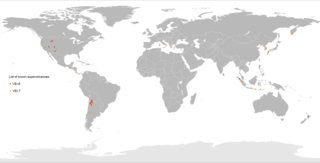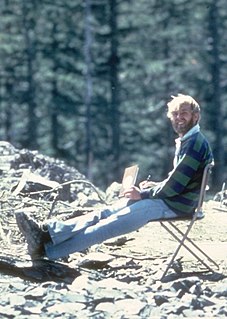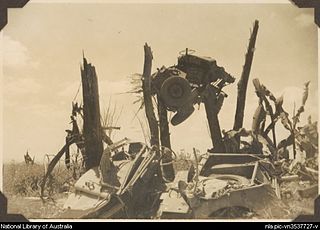
A supervolcano is a volcano that has had an eruption with a Volcanic Explosivity Index (VEI) of 8, the largest recorded value on the index. This means the volume of deposits for such an eruption is greater than 1,000 cubic kilometers.

A volcano is a rupture in the crust of a planetary-mass object, such as Earth, that allows hot lava, volcanic ash, and gases to escape from a magma chamber below the surface.

Volcanology is the study of volcanoes, lava, magma and related geological, geophysical and geochemical phenomena (volcanism). The term volcanology is derived from the Latin word vulcan. Vulcan was the ancient Roman god of fire.

Mount Pelée or Mont Pelée is an active volcano at the northern end of Martinique, an island and French overseas department in the Lesser Antilles Volcanic Arc of the Caribbean. Its volcanic cone is composed of stratified layers of hardened ash and solidified lava. Its most recent eruption was in 1932.

A volcanologist, or volcano scientist, is a geologist who focuses on understanding the formation and eruptive activity of volcanoes. Volcanologists frequently visit volcanoes, sometimes active ones, to observe and monitor volcanic eruptions, collect eruptive products including tephra, rock and lava samples. One major focus of inquiry in recent times is the prediction of eruptions to alleviate the impact on surrounding populations and monitor natural hazards associated with volcanic activity. Geologists who research volcanic materials that make up the solid Earth are referred to as igneous petrologists.

Lassen Volcanic National Park is an American national park in northeastern California. The dominant feature of the park is Lassen Peak, the largest plug dome volcano in the world and the southernmost volcano in the Cascade Range. Lassen Volcanic National Park is one of the few areas in the world where all four types of volcano can be found—plug dome, shield, cinder cone, and stratovolcano.

Dante's Peak is a 1997 American disaster thriller film directed by Roger Donaldson, written by Leslie Bohem, and starring Pierce Brosnan, Linda Hamilton, and Charles Hallahan. The film is set in the fictional town of Dante's Peak where the inhabitants fight to survive a volcanic eruption from a long dormant stratovolcano that has suddenly woken up. The film was released on February 7, 1997, under the production of Universal Pictures and Pacific Western Productions. It received negative reviews from critics and became a box-office bomb, despite this, it has since gained a cult following among disaster film aficionados. It was the last film Charles Hallahan starred in before his death nine months later in November 1997.

Catherine Joséphine "Katia" Krafft and her husband, Maurice Paul Krafft, were Alsatian French volcanologists who died in a pyroclastic flow on Mount Unzen, in Japan, on June 3, 1991. The Kraffts were known for being pioneers in filming, photographing and recording volcanoes, often getting within feet of lava flows. Their obituary appeared in the Bulletin of Volcanology. Werner Herzog's documentaries Into the Inferno and The Fire Within: Requiem for Katia and Maurice Krafft highlight them. A documentary of their career using their footage has been produced, Fire of Love.

Volcano is a 1997 American disaster film directed by Mick Jackson and produced by Neal H. Moritz and Andrew Z. Davis. The film stars Tommy Lee Jones, Anne Heche, Don Cheadle, and Keith David, and tells the story of an effort to divert the path of a dangerous lava flow through the streets of Los Angeles following the formation of a volcano at the La Brea Tar Pits. The storyline was conceived from a screenplay written by Jerome Armstrong and Billy Ray, and was inspired by the 1943 formation of the Parícutin volcano in Mexico.

Mount Unzen is an active volcanic group of several overlapping stratovolcanoes, near the city of Shimabara, Nagasaki on the island of Kyushu, Japan's southernmost main island.

David Alexander Johnston was an American United States Geological Survey (USGS) volcanologist who was killed by the 1980 eruption of Mount St. Helens in the U.S. state of Washington. A principal scientist on the USGS monitoring team, Johnston was killed in the eruption while manning an observation post six miles (10 km) away on the morning of May 18, 1980. He was the first to report the eruption, transmitting "Vancouver! Vancouver! This is it!" before he was swept away by a lateral blast; despite a thorough search, Johnston's body was never found, but state highway workers discovered remnants of his USGS trailer in 1993.
The Decade Volcanoes are 16 volcanoes identified by the International Association of Volcanology and Chemistry of the Earth's Interior (IAVCEI) as being worthy of particular study in light of their history of large, destructive eruptions and proximity to densely populated areas. The Decade Volcanoes project encourages studies and public-awareness activities at these volcanoes, with the aim of achieving a better understanding of the volcanoes and the dangers they present, and thus being able to reduce the severity of natural disasters.

Several types of volcanic eruptions—during which lava, tephra, and assorted gases are expelled from a volcanic vent or fissure—have been distinguished by volcanologists. These are often named after famous volcanoes where that type of behavior has been observed. Some volcanoes may exhibit only one characteristic type of eruption during a period of activity, while others may display an entire sequence of types all in one eruptive series.

Magma: Volcanic Disaster is a 2006 disaster film by Sci Fi Pictures. Written by Rebecca Rian and directed by Ian Gilmour, the film stars Xander Berkeley and Amy Jo Johnson. It was filmed in Bulgaria.

The Silverthrone Caldera is a potentially active caldera complex in southwestern British Columbia, Canada, located over 350 kilometres (220 mi) northwest of the city of Vancouver and about 50 kilometres (31 mi) west of Mount Waddington in the Pacific Ranges of the Coast Mountains. The caldera is one of the largest of the few calderas in western Canada, measuring about 30 kilometres (19 mi) long (north-south) and 20 kilometres (12 mi) wide (east-west). Mount Silverthrone, an eroded lava dome on the caldera's northern flank that is 2,864 metres (9,396 ft) high, may be the highest volcano in Canada.

The Mount Edziza volcanic complex is a large and potentially active north-south trending complex volcano in Stikine Country, northwestern British Columbia, Canada, located 38 kilometres (24 mi) southeast of the small community of Telegraph Creek. It occupies the southeastern portion of the Tahltan Highland, an upland area of plateau and lower mountain ranges, lying east of the Boundary Ranges and south of the Inklin River, which is the east fork of the Taku River. As a volcanic complex, it consists of many types of volcanoes, including shield volcanoes, calderas, lava domes, stratovolcanoes, and cinder cones.

Disaster Zone: Volcano in New York is a 2006 American television disaster film directed by Robert Lee. It stars Costas Mandylor, Alexandra Paul, and Michael Ironside. It was produced by Front Street Pictures and Lava Lane Productions and was distributed by Echo Bridge Home Entertainment.

Barry Voight is an American geologist, volcanologist, author, and engineer. After earning his Ph.D. at Columbia University, Voight worked as a professor of geology at several universities, including Pennsylvania State University, where he taught from 1964 until his retirement in 2005. He remains an emeritus professor there and still conducts research, focusing on rock mechanics, plate tectonics, disaster prevention, and geotechnical engineering.
Volcano: Fire on the Mountain is a 1997 American television disaster film starring Cynthia Gibb and Dan Cortese, with a coincidentally similar theme to Dante's Peak theatrically released the same year.

The catastrophic 1951 eruption of Mount Lamington occurred in Oro Province, Territory of Papua and New Guinea on the island of Papua. Prior to the eruption, Mount Lamington was not recognized as a volcano due to the absence of historically-recorded eruptions and dense vegetation cover. In early January 1951, a series of minor explosions and earthquakes rocked the volcanic mountain. From January 15, volcanic activity intensified, and tall eruption plumes were generated. The largest eruption occurred on the morning of January 21 when a thick black plume of ash rose 50,000 feet into the atmosphere. The eruption collapsed a lava dome and produced a lethal pyroclastic flow that killed 2,942–3,466 people. In the years after the eruption, new lava domes formed and collapsed in succession. Activity persisted until July 1956. The eruption is the deadliest natural disaster in Australian history, as the region was under the rule of the Government of Australia.